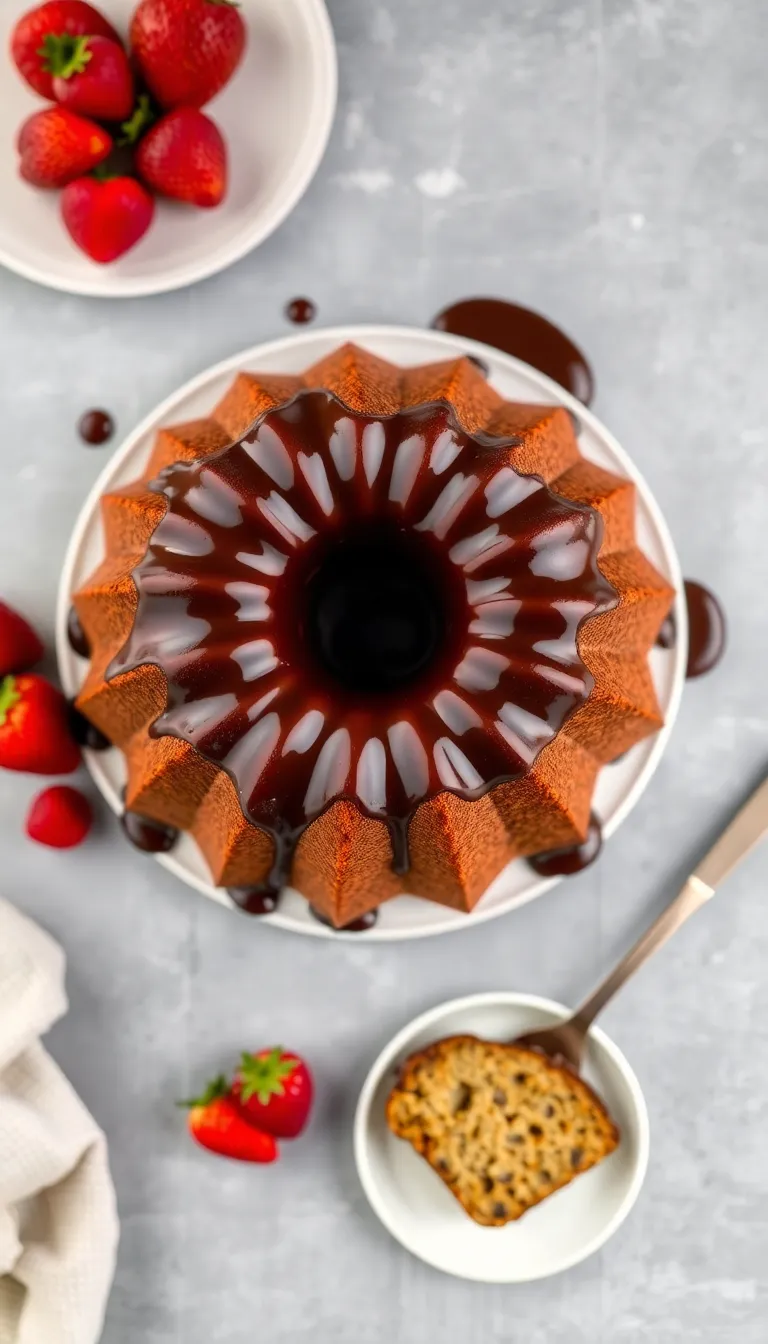Picture this: a glossy, decadent chocolate glaze cascading down the curves of your Bundt cake, making it look like it belongs in a bakery window. No one needs to know it took you five minutes to make. This glaze isn’t just good—it’s the kind of thing that’ll have people asking for your “secret recipe” (which, FYI, you’re about to get).
Skip the sad, lumpy glazes of your past. This one’s foolproof, rich, and so shiny you could check your reflection in it. Ready to upgrade your cake game?
Why This Chocolate Glaze Recipe Works
This glaze is the Goldilocks of toppings—not too thick, not too thin, just right.
It clings to every nook of your Bundt cake without drowning it. The magic? A combo of high-quality chocolate and just enough butter for richness without turning into a grease puddle.
Plus, it sets perfectly: firm enough to slice but soft enough to melt in your mouth. It’s basically the little black dress of dessert toppings—simple, elegant, and goes with everything.
Ingredients You’ll Need
- 1 cup heavy cream (or sub half-and-half if you’re in a pinch)
- 8 oz semi-sweet chocolate (chips or chopped bars—no weird baking chocolate)
- 2 tbsp unsalted butter (because salted butter in desserts is a crime, IMO)
- 1 tsp vanilla extract (optional, but why skip it?)
- Pinch of salt (to make the chocolate taste more chocolatey, science says so)
Step-by-Step Instructions
- Heat the cream: In a small saucepan, warm the heavy cream over medium heat until it’s just simmering. Don’t let it boil—you’re making glaze, not scrambled cream.
- Melt the chocolate: Pour the hot cream over the chocolate in a heatproof bowl.
Let it sit for 2 minutes (patience is a virtue).
- Stir: Gently whisk until the chocolate is fully melted and smooth. If you see lumps, keep stirring—they’ll surrender eventually.
- Add butter and vanilla: Toss in the butter, vanilla, and salt. Stir until the butter disappears.
Congrats, you’ve just made glossy magic.
- Cool slightly: Let the glaze sit for 5–10 minutes so it thickens slightly. Too runny, and it’ll slide right off your cake. Too thick, and it’ll look like frosting.
Aim for the sweet spot.
- Pour: Drizzle over your cooled Bundt cake. Pro tip: Put the cake on a wire rack with parchment underneath for easy cleanup.
How to Store Leftovers (If There Are Any)
Cover the glazed cake with a dome or plastic wrap and keep it at room temp for up to 2 days. For longer storage, refrigerate for up to 5 days, but let it come to room temp before serving—cold chocolate is sad chocolate.
Unused glaze can be refrigerated in an airtight container for a week. Reheat gently in the microwave (stirring every 15 seconds) or over a double boiler.
Why This Recipe is a Game-Changer
It’s fast, foolproof, and makes any cake look professional. No corn syrup, no weird ingredients—just real chocolate doing its thing.
It’s also versatile: swap the chocolate for dark or white, or add espresso powder for a mocha twist. Plus, it’s forgiving. Overheat it?
Add more chocolate. Too thick? A splash of cream fixes it.
This is the glaze that’ll never let you down.
Common Mistakes to Avoid
- Boiling the cream: Scalded cream = grainy glaze. Keep it at a simmer.
- Using low-quality chocolate: Cheap chocolate won’t melt smoothly. Spend the extra $2.
- Pouring on a warm cake: Heat makes the glaze slide right off.
Cool your cake first.
- Over-stirring: Aggressive whisking can make the glaze greasy. Be gentle.
Alternatives and Twists
Not feeling semi-sweet? Try dark chocolate for a richer glaze or white chocolate for a sweeter vibe.
Add a tablespoon of bourbon or orange liqueur for an adult twist. For a dairy-free version, use coconut cream and vegan butter. Want color?
Mix in a pinch of powdered food coloring (liquid will thin the glaze).
FAQs
Can I use milk instead of heavy cream?
Technically, yes, but the glaze will be thinner and less rich. Heavy cream gives it that luxurious texture—don’t cheat yourself.
Why is my glaze lumpy?
Either the cream was too hot (scorched the chocolate) or the chocolate wasn’t fully melted. Strain it through a sieve to save it.
Can I make this ahead?
Absolutely.
Make the glaze, cool it completely, and store it in the fridge. Reheat gently before using.
How do I fix too-thin glaze?
Add more melted chocolate (about 1 oz at a time) or let it cool longer. Too thick?
Stir in warm cream, a teaspoon at a time.
Will this work on cupcakes?
Yep! Dip the tops of cooled cupcakes for a smooth finish, or drizzle for a rustic look.
Final Thoughts
This chocolate glaze is the easiest way to make a Bundt cake look like it took hours. It’s rich, shiny, and practically begs to be Instagrammed.
Whether you’re a baking pro or a “store-bought mix” person, this recipe won’t judge you. Now go pour that glaze and bask in the compliments. You’re welcome.






